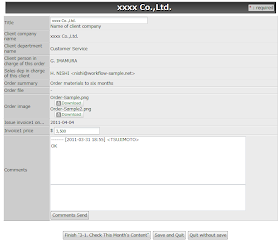We've already introduced several examples involving billing processes, but today let's look at an example of a company that issues multiple invoices in response to one order.
<Related>
- Cross-Sectional Collaborative Workflow for Invoice Issuance
- A Workflow that Automatically Starts Invoice Issuance Process
<Tasks>
1. Input Invoice Data, 2. Confirm Invoice Data, 3-1. Check This Month's Content, 4-1. Send Invoice, 5-1. Confirm Payment
[Invoice Issuance <Issue By Order>: "3-1. Check This Month's Content" screen]
This is a relatively simple workflow. When an order for six months comes in, the accounting team can manage each month's invoice issuance and payment. This will work with any number of months. It's also easy to change the content at task 3 (Check This Month's Content). It might be good to have an automatic email sent to sales members every time an invoice is issued.
However, if a lot of customers tend to extend their orders, this may not be the ideal workflow.
The below workflow initiates processes according to the number of issued invoices, instead of the number of orders. Specifically, once an invoice is issued the next month's invoice process is initiated. Of course, it's important that the order information is taken over to the new process, and that the system can work flexibly to changes in billing information.
<Tasks>
1. Input Invoice Issuance Date (Month), 2. Confirm Invoice Data, 3. Check Invoice Content (7 days before sending), 4. Send Invoice, 5. Confirm Payment



